I knew very little about Nagoya before I got there. I knew about its Toyota and railway museums but I had no idea how good the food in Nagoya would be.
It wasn’t until I arrived in Kyoto and went on a food tour that I learned how prominent a food city Nagoya actually is. According to my tour guide Syouri, it’s one of three cities that the Japanese often visit when they travel for food, the other two being Fukuoka and Hiroshima.
In fact, so special is the food in Nagoya that they even have a specific term for it. They call it Nagoya meshi, which roughly translates to “Nagoya food” or “Nagoya cuisine”. It’s a way of acknowledging the city’s unique regional cuisine regarded as one of the best in Japan.
It’s funny, I didn’t know about its reputation as a food city but I remember being struck by how good the food in Nagoya was. The time I spent hopping between restaurants in Nagoya was one of the best eating experiences I’ve had so far in Japan.
FOOD IN NAGOYA QUICK LINKS
To help you plan your trip to Nagoya, we’ve compiled links to recommended hotels, tours, and other activities here.
HOTELS
Recommended hotels around Nagoya Station, the most convenient area to stay for first-time visitors to the city.
- Luxury: The Tower Hotel Nagoya
- Midrange: Hotel Vista Nagoya Nishiki
- Budget: Choukou Hotel
TOURS
- Food Tour: Private and Personalized Eat Like a Local Tour
- Tea Ceremony: Nighttime Tea Ceremony Experience
- Cooking Class: Nagoya-Style Home Cooking Class
OTHER SERVICES
Save This on Pinterest!
No time to read this Nagoya food guide now? Click on the save button and pin it for later!

WHAT IS NAGOYA MESHI?
Nagoya meshi refers to the regional cuisine of Nagoya and its surrounding areas in central Japan. Its characterized by its use of local vegetables and ingredients and the melding of foreign influences such as Italian, Taiwanese, and mainland Chinese cuisines.
Among the ingredients that best define Nagoya cuisine are unagi (freshwater eel), Nagoya cochin (chicken), tamari (soy sauce), and mame miso. Of these ingredients, perhaps most important is mame miso.
Mame or red miso refers to the purest form of miso made only with soybeans. It undergoes a long fermentation process – at least two years – to produce a dark and intensely flavored miso. Hatcho miso is the most famous type of red miso and gives key Nagoya dishes like miso katsu, miso nikomi udon, and doteni their distinct flavor.
Miso is said to be so vital to Nagoya cuisine that Nagoya locals are jokingly accused of putting it on everything.
WHAT TO EAT IN NAGOYA
This isn’t a definitive list but described below are the most important local dishes in Nagoya cuisine, as well as recommendations on which Nagoya restaurants you can visit to try them.
It’s easy enough to try all these dishes on your own at Nagoya restaurants, but if you’d like to go with a guide, someone who can explain Nagoya meshi to you in more detail, then you may be interested in booking a Nagoya food tour.
1. Miso Katsu
Miso katsu is perhaps the one dish that best represents Nagoya cuisine. It refers to pork tonkatsu served with a thick sauce made with Hatcho miso.
Personally, I like tonkatsu but it isn’t a dish I’d look for all the time. But drench it in a rich thick miso sauce and it shoots up many spots on my list of favorite Japanese dishes.
Tonkatsu refers to a deep-fried breaded pork cutlet. Popular throughout Japan, it’s made with a 2-3 cm slice of pork loin or tenderloin coated with panko bread crumbs and deep-fried in oil. It’s typically served in a set meal with a sweet-savory tonkatsu sauce, rice, shredded cabbage, and pickled vegetables.
Miso katsu is a regional version of tonkatsu popular in Nagoya and Aichi prefecture. The deep-fried pork cutlet is the same but what makes it different is the sauce. Instead of being served with regular tonkatsu sauce made with the usual ingredients like soy sauce, ketchup, and Worcestershire sauce, it’s main ingredient is Hatcho miso.
Pictured below is the delicious pair of cutlets I enjoyed at Yabaton, one of the best places to eat miso katsu in Nagoya. One was completely drenched in miso sauce while the other was more lightly sauced, to keep the cutlet crunchy.
RECIPE: Miso katsu
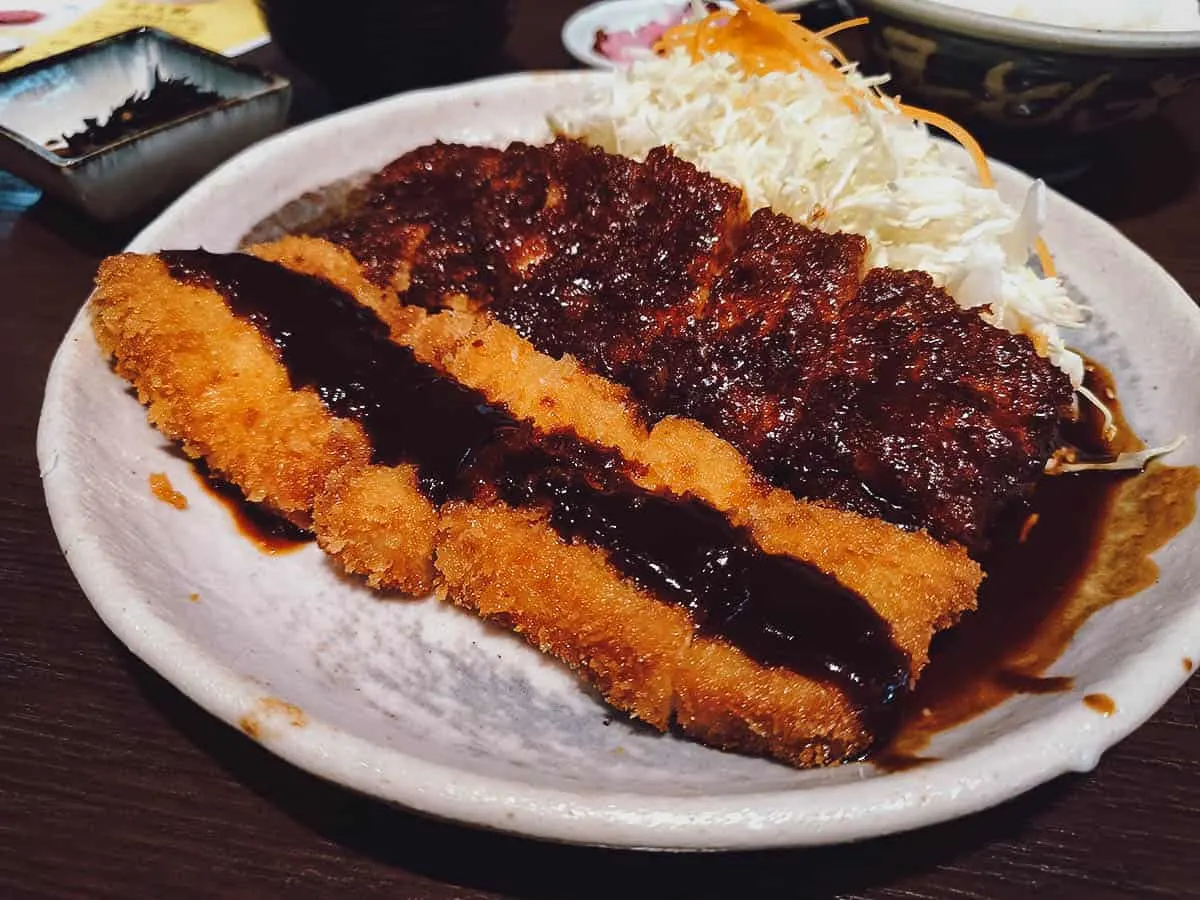
Here’s a closer look at that soft and juicy pork cutlet dripping in rich miso sauce. Aside from using the best type of miso, Yabaton also uses the best type of pork.
Yabaton makes their cutlets with Kurobuta pork which is a breed of black pig from Kagoshima prefecture. These pigs have been reared in Kagoshima for over 400 years and fed a diet consisting mainly of sweet potatoes. Clean, flavorful, and incredibly juicy, they’re considered the best pork brand in Japan and often referred to as the “Kobe beef of pork”.
Being one of Japan’s most prominent food cities, there are many delicious things to eat in Nagoya, but miso katsu is one of two dishes that you definitely shouldn’t miss. The other is hitsumabushi.
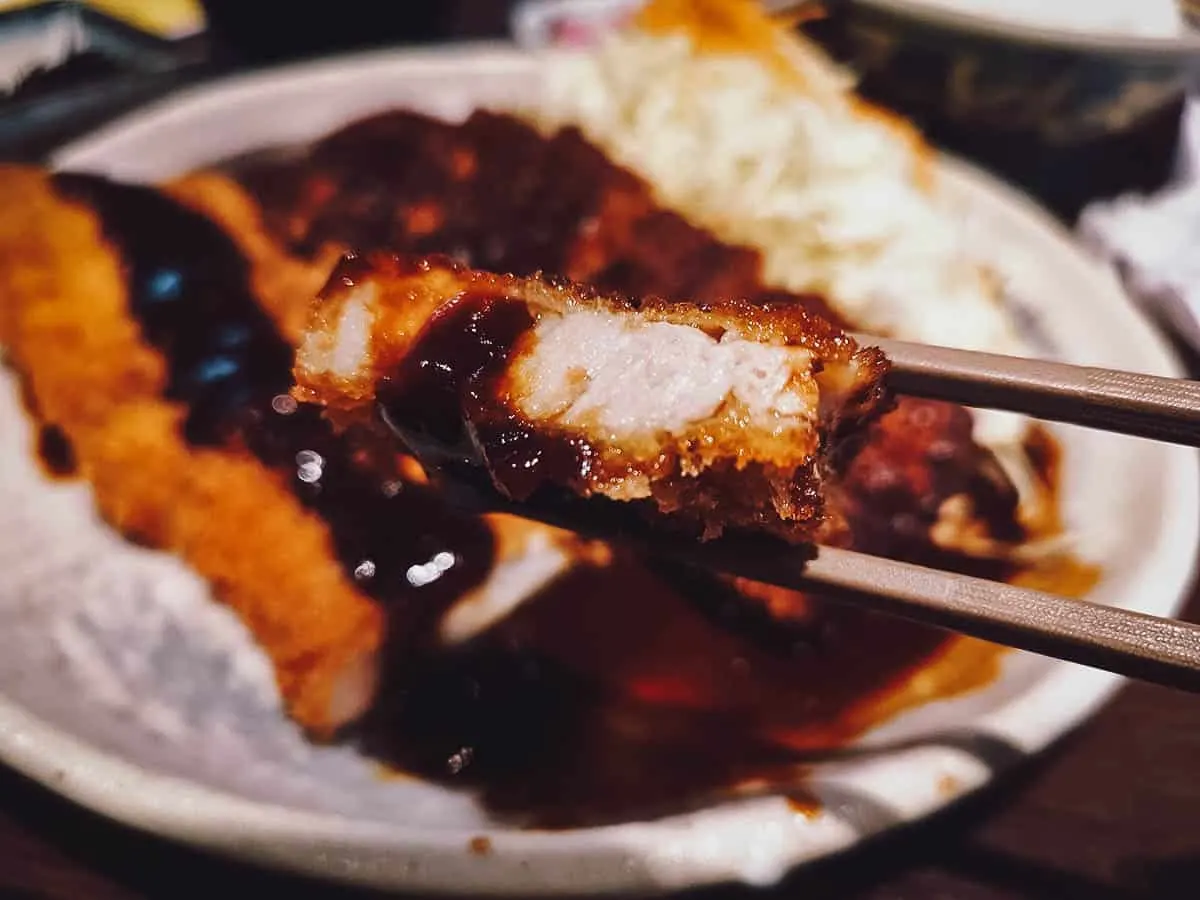
2. Hitsumabushi
Along with miso katsu, I think that hitsumabushi is one of the best regional dishes you can have in Nagoya. A specialty of Aichi prefecture, it refers to a dish of grilled unagi (freshwater eel) served over a bed of rice.
If you’ve had unagi donburi or unajyu, then this dish probably looks familiar. It’s similar but with a few key differences, mainly in how it’s prepared and how it’s eaten.
Hitsumabushi is prepared in the Nagoya style of cooking eel, by slitting it open along the belly and grilling it whole without steaming. It’s also sliced in narrower strips to make it easier to eat.
Unlike unagi donburi, hitsumabushi is served with a host of condiments like wasabi, nori, grated radish, and Japanese pepper. You’re meant to eat the eel in three stages – the first on its own with rice, the second with the condiments, and the third with some dashi broth poured into your bowl.
It’s a unique and interesting way of consuming grilled eel that may not be as familiar to some people as unagi donburi. It’s like having unagi three ways in one meal.
Here’s my hitsumabushi set meal with condiments and miso soup.
RECIPE: Hitsumabushi

Here’s a closer look at the sliver of grilled unagi coated in a thick, sweet soy sauce-based sauce. The eel in unagi donburi or unajyu is never sliced this thinly.
This isn’t as important but another distinction between hitsumabushi, unagi donburi, and unajyu is the vessel in which they’re served. Hitsumabushi is typically served in a deep circular container known as ohitsu. Unagi donburi (unadon for short) is served in a round bowl while unajyu is served in a square lacquered box.
Hitsumabushi is a variation of the other two but as far as I know, there are no differences between unadon and unajyu other than the vessel used to serve them.
As much as I love grilled eel, it’s fairly pricey in Japan so it isn’t something I can have often. My search for highly-rated but reasonably priced hitsumabushi in Nagoya led me to Maruya. I went to their main branch at JR Nagoya Station but they have several outlets throughout the city.

3. Kishimen
Kishimen is another specialty of Aichi prefecture. It refers to a type of udon noodle that’s broad and flat. I learned how to make udon noodles in a Tokyo cooking class and the teacher specifically told me to cut the flat noodles thinly, otherwise I’d be making Nagoya-style noodles.
Kishimen can be prepared in any number of ways – hot or cold and seasoned with salt, soy sauce, miso, or curry. The most traditional version seems to be served in a hot broth with steamed fish cakes, spinach, deep-fried tofu, green onion, and bonito flakes.
RECIPE: Kishimen
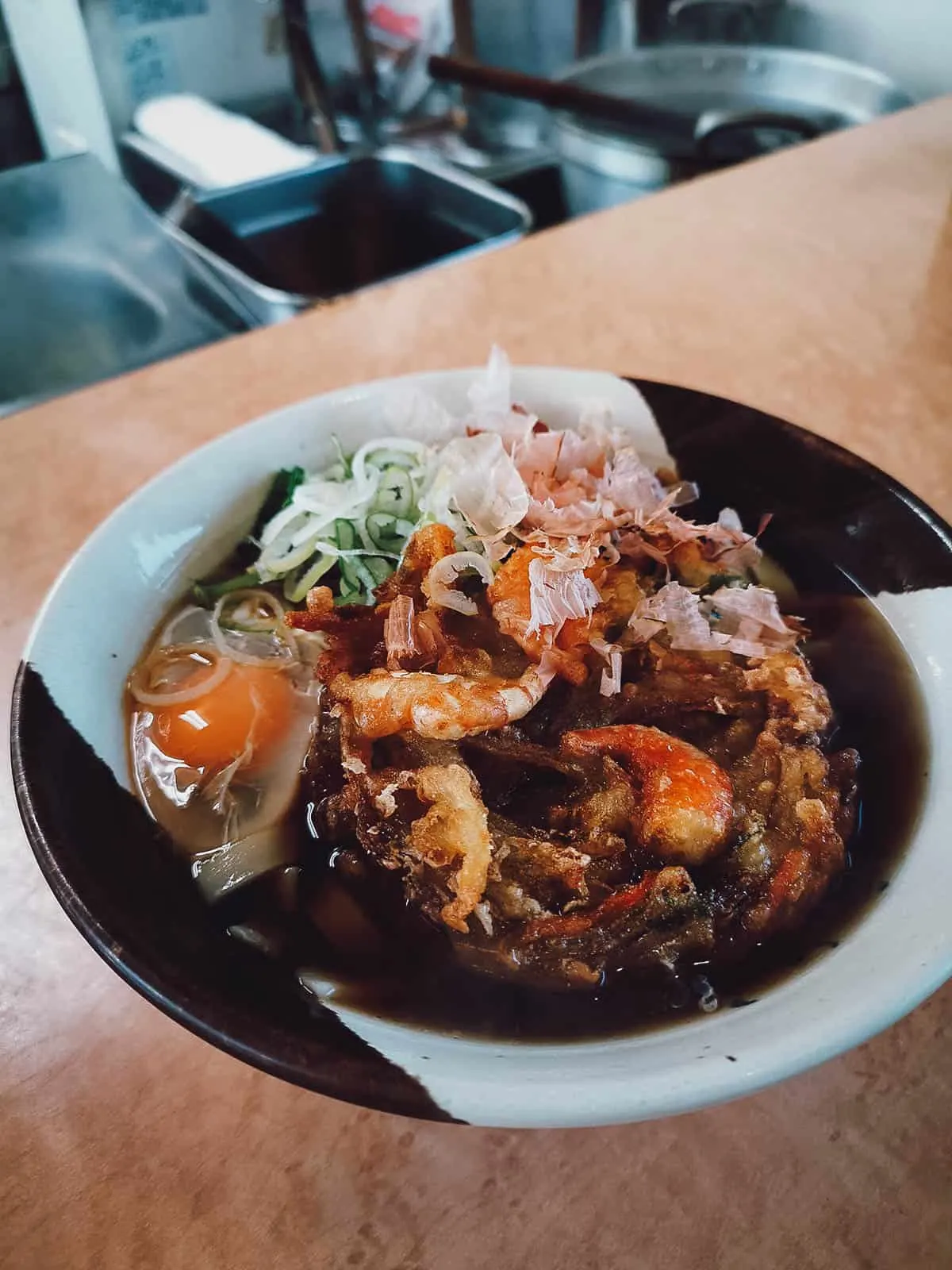
You can find kishimen pretty much anywhere in Nagoya. It’s a mainstay on many Nagoya menus, even on the grounds of Atsuta Shrine. I had this bowl at Nadai Kishimen Sumiyoshi while waiting for my train. It’s a small shop located on the platform between tracks 10 and 11 at JR Nagoya Station.
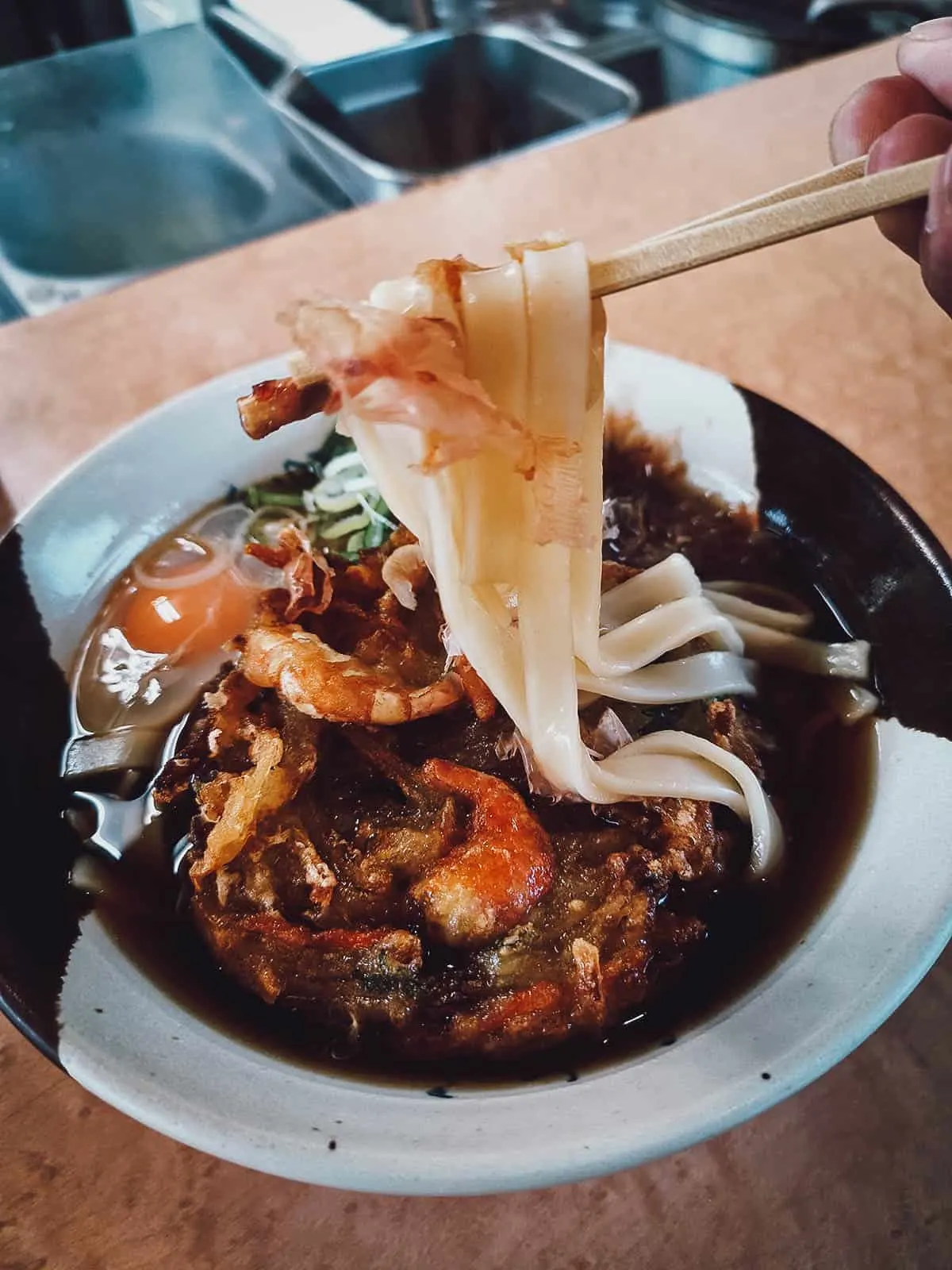
4. Tenmusu
Tenmusu refers to a bite-sized rice ball wrapped with nori and filled with deep-fried shrimp tempura. It’s originally from Mie Prefecture but it’s now regarded as a specialty dish of Nagoya.
Tenmusu can be enjoyed on its own or served in a bento box. I got this takeaway pack of six from Ganso Tenmusu Senju, the restaurant credited for inventing this dish. Ganso Tenmusu Senju means “the birthplace of tenmusu”.
The original restaurant is located in Tsu City in Mie Prefecture but they’ve since opened branches in Nagoya as well. They garnish their tenmusu with kyarabuki which are butterbur stems boiled in a soy-sauce-based soup.
RECIPE: Tenmusu

5. Doteni
Doteni is a dish of beef tendon, innards, and daikon radish simmered in Hatcho miso sauce. It’s a staple izakaya dish and something that you absolutely need to try in Nagoya.
RECIPE: Horumon no doteni

I’m not sure what this is but it looks to be a piece of beef intestine. Like miso katsu, the flavor from the Hatcho miso is what really makes this dish. The soft and chewy innards explode with umami flavor and go so well with beer.
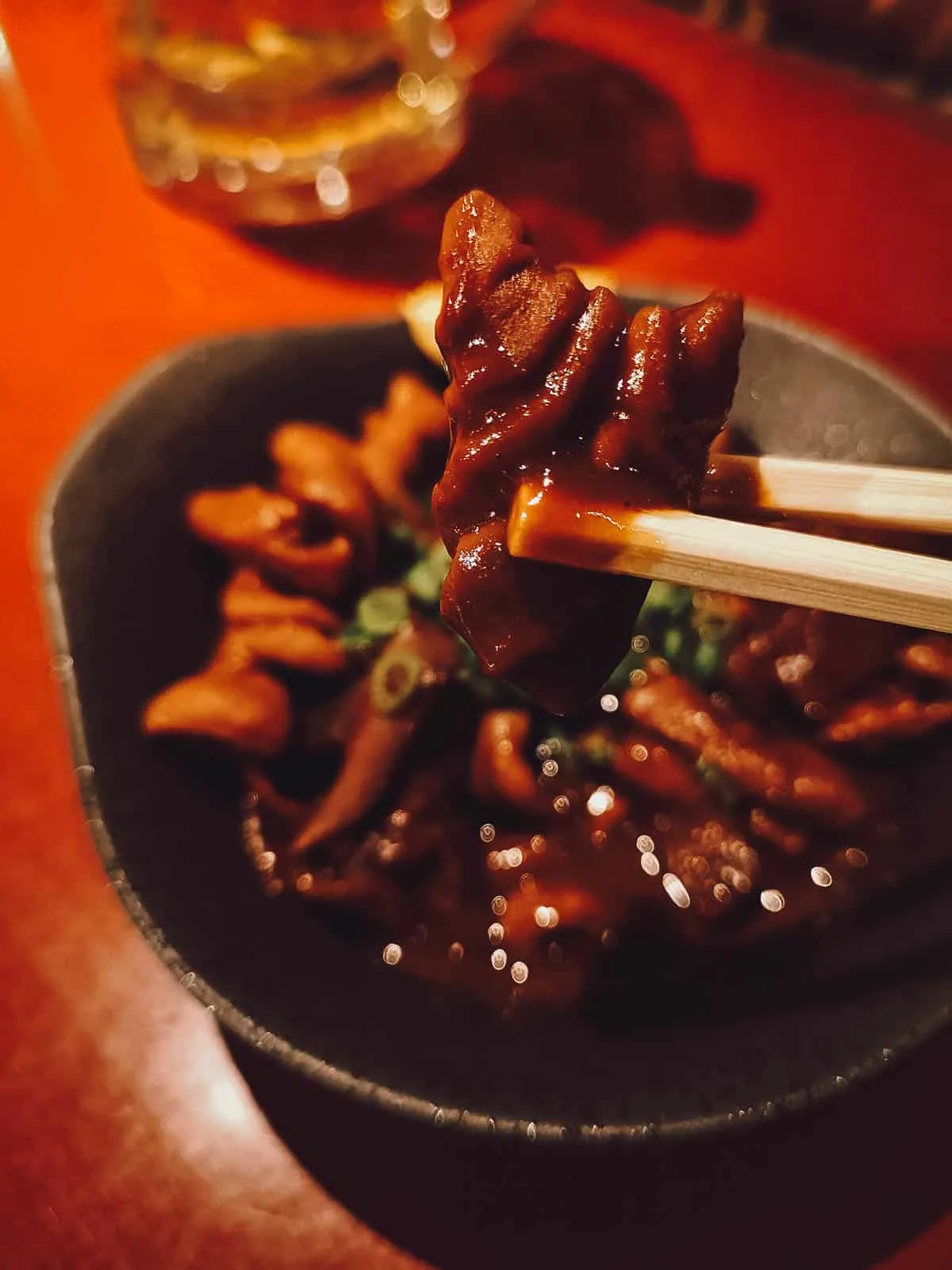
6. Tebasaki
Tebasaki refers to deep-fried chicken wings. They’re available throughout Japan but they seem to have originated in Nagoya. They’re made with non-battered bone-in chicken wings that are double fried to achieve a supremely crisp but delicate coating.
Seasonings may vary from izakaya to izakaya but most will be coated in a sticky, savory-sweet glaze. Mine were lightly coated but I’ve seen versions with a much heavier glaze and dredged in sesame seeds. The best tebasaki is said to be made with Nagoya cochin, one of the most famous chicken breeds in Japan.
Tebasaki reminds me a lot of Korean fried chicken. They’re both double fried, a little sticky, a bit sweet, and go supremely well with beer.
I went to this izakaya but there are many around JR Nagoya Station. To be honest, I was a bit nervous to walk in at first. I had read negative reviews describing these Nagoya izakayas as being averse to foreigners but I didn’t get that feeling at all. On the contrary, the servers were quite nice and accommodating.
RECIPE: Tebasaki
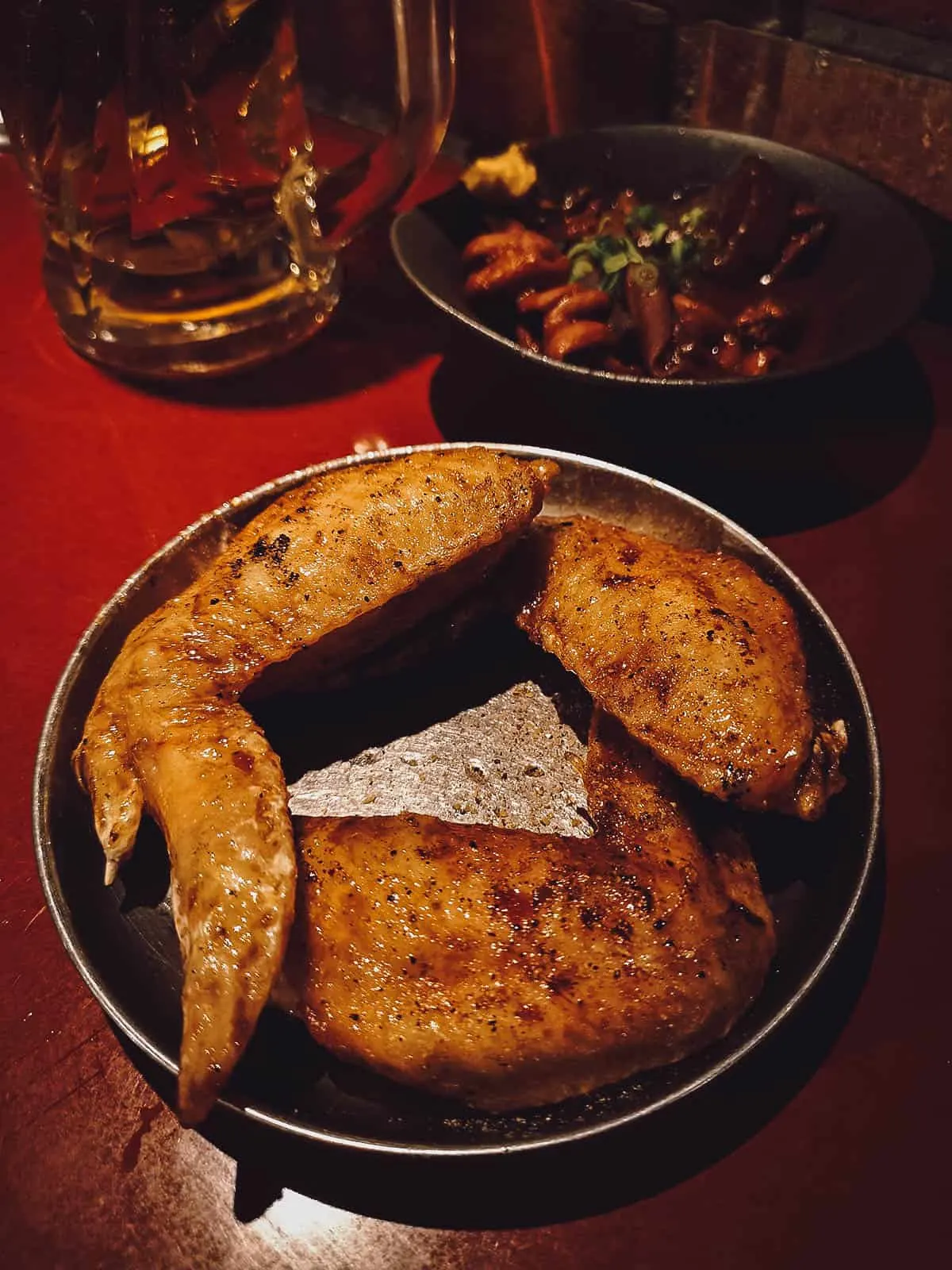
7. Miso Nikomi Udon
Miso nikomi udon is a soup dish made with udon noodles simmered in a miso-flavored dashi broth. It’s served in a clay pot and typically made with chicken, fish cake, green onion, mushroom, and egg. I had a version topped with a lone piece of ebi tempura.
Like miso katsu and doteni, the best Nagoya restaurants make their miso nikomi udon with Hatcho miso. It’s what gives the dish its signature flavor.
RECIPE: Miso nikomi udon

Like miso katsu and hitsumabushi, miso nikomi udon is one of the best examples of Nagoya meshi. The bowl I had was unremarkable but I read that one of the best restaurants in Nagoya to try it is Yamamotoya.
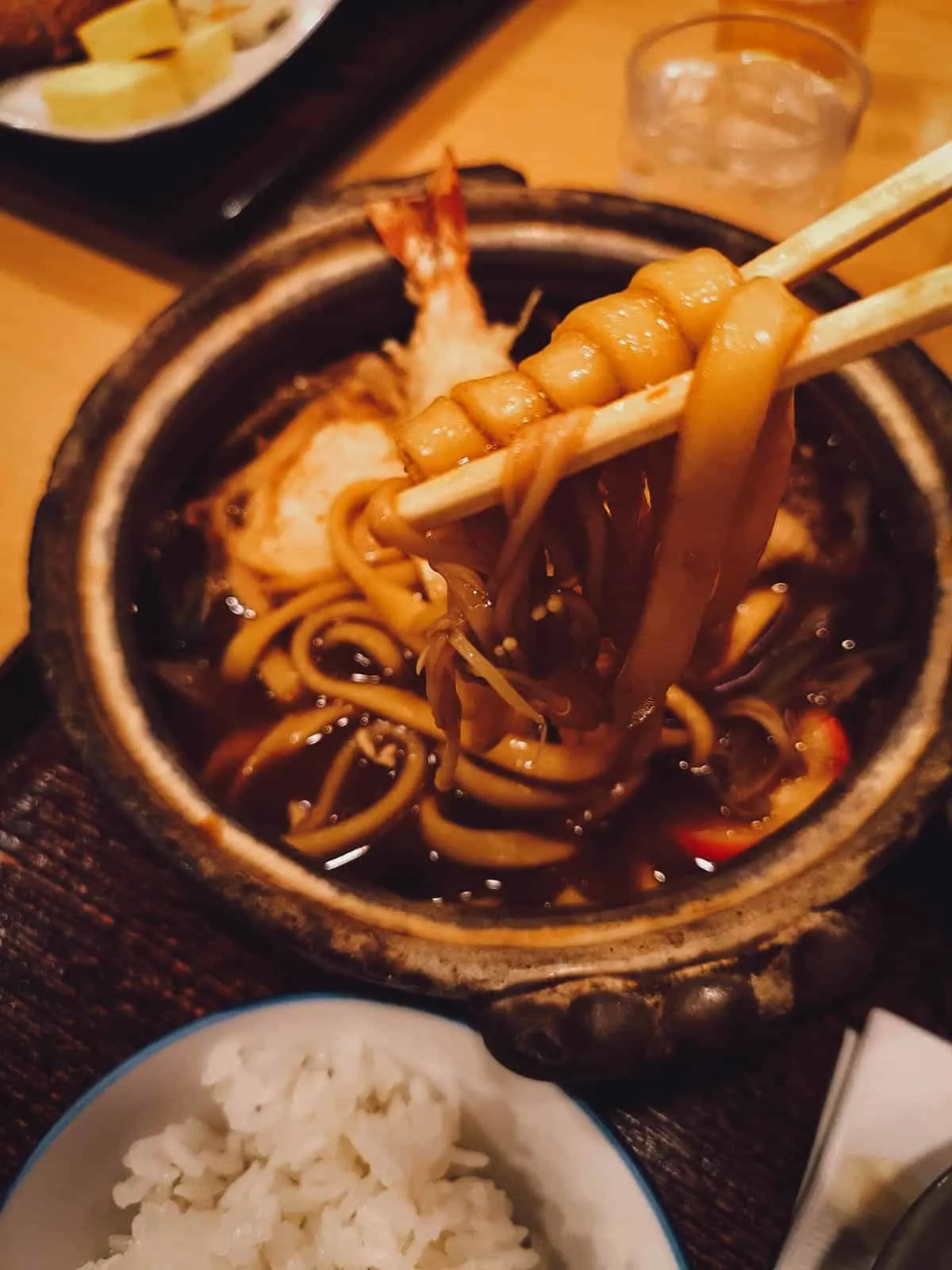
8. Nagoya Sweets
I’m not as into dessert so I don’t know as much about this, but my wife is convinced that Nagoya is famous for its pastries and sweets. She kept seeing confection after confection on her Instagram feed. I was positive this was due to algorithms and user behavior but a quick Google search seemed to indicate that she may be right.
Based on more than one article, Nagoya does seem to have a reputation for its desserts. Uiro, kaeru manju, oni manju, piyorin, and Nagoya financier made with matcha and miso were just a few of the goodies that came up when searching for Nagoya sweet treats.
These aren’t specific to Nagoya but my wife wanted me to bring her back some caneles so I found this one shop that carried them. I told her that the financier is probably more representative of Nagoya but she insisted on caneles!
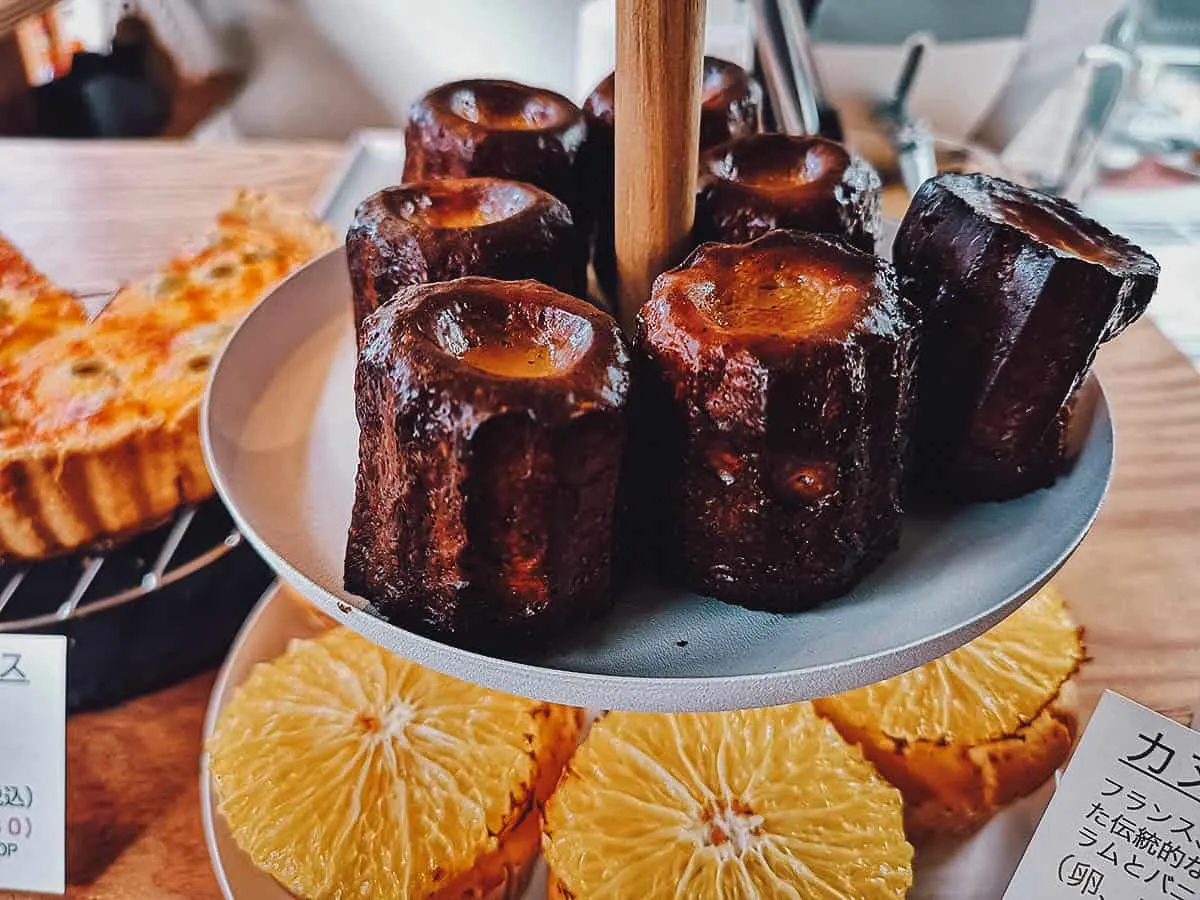
NAGOYA FOOD TOURS
No one knows the food in Nagoya better than a local, so what better way to experience Nagoya meshi than by going on a food tour? A knowledgeable local will take you to Nagoya’s best restaurants and explain all the dishes to you in more detail. Check out Get Your Guide for a list of Nagoya meshi food tours in the city.
FINAL THOUGHTS ON THE FOOD IN NAGOYA
Had I known about the reputation of the food in Nagoya, then I would have done more research on it. The most important dishes are spoken for in this guide but there are more Nagoya dishes to try like ebi furai, ebisen (shrimp rice crackers), miso oden, oni manju, and ogura toast with sweet red bean paste.
Plus you have the odd-sounding dishes birthed by the influence of foreign cuisines like ankake spaghetti, teppan spaghetti, and Indian spaghetti. I checked if Nagoya had its own version of ramen and two types of Nagoya ramen came up – Taiwan ramen and Sugakiya Ramen.
Taiwan ramen refers to a recreation of a spicy Taiwanese noodle dish made with ground pork, chives, green onions, and red chilies. Sugakiya Ramen isn’t a specific dish but a popular ramen chain in central Japan. It’s known for being the country’s cheapest ramen chain and features a tonkotsu-style ramen that’s meant to be eaten with a ramen spork!
As always, this Nagoya food guide is a work-in-progress that will only grow with each return visit to central Japan. With so much good food in Nagoya, you can bet your Hatcho miso we’ll be back.
Disclosure
Some of the links in this Nagoya food guide are affiliate links, meaning we’ll earn a small commission if you make a purchase at no additional cost to you. As always, we only recommend products and services that we use ourselves and firmly believe in. We really appreciate your support as this helps us make more of these free travel guides. Arigato gozaimasu!

